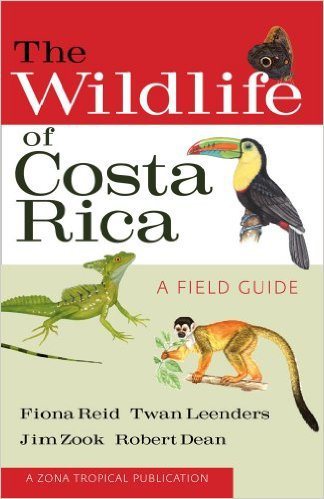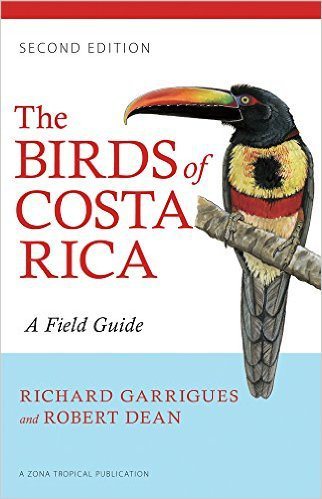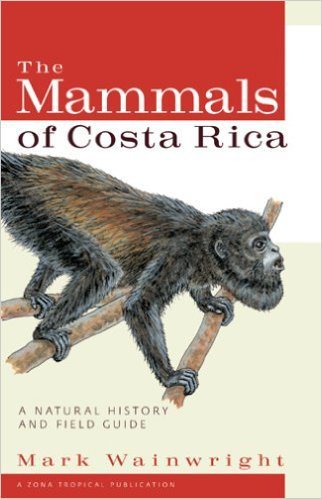Matthew Houde's Blog, page 32
August 27, 2015
Weather in Costa Rica: What You Need to Know
Two Weeks in Costa Rica |
So your favorite weather app is telling you that in Costa Rica, it is pouring buckets and shooting lightning bolts every single day. Of course you’re stressed. You’ve already spent a lot on plane tickets, hotels, and everything else, and you don’t want your trip to be a washout. Before you start canceling plans or stocking up on ponchos, there are a few things you need to know about the weather in Costa Rica. In this post, we’ll take a look at how the weather is predicted, discuss the different seasons, and let you know as best as we can what to expect for your trip.

Is the Forecast Reliable?
The short answer is no. Forecasting the weather in Costa Rica is a complicated job. This tiny country is located very close to the equator, is nestled between two churning oceans, and has several steep mountain ranges down the center. All of these factors make forecasting difficult.
There is also very limited weather infrastructure in Costa Rica. Unlike other countries where radar towers pick up every drop of precipitation, meteorologists here analyze satellite images of cloud cover instead. The problem is that those clouds change quickly, especially over ocean and mountain, so forecasting their direction more than a day in advance is a real challenge. This is one reason why your weather app often gives you an extended forecast that shows a chance of thunderstorms and rain for several days in a row.
Costa Rica’s Seasons
Costa Rica has two seasons: the dry season and the rainy or “green” season. During the months of December to April, the dry season, much of the country experiences little if any rain.
To really get a sense of the seasonality of rainfall, check out this chart we made with data from Costa Rica’s National Meteorological Institute. Each line represents a different area of the country and its corresponding days of rainfall per month.

What Does the Chart Mean?
Basically, for about five months of the year, most locations see less than five or so days with rain. That means it is virtually dry in most areas of the country from December to April. One exception is the Caribbean coast (in yellow), which has its own unique weather patterns with more consistent year-round rain.
Location, Location, Location
Another thing the chart shows is that location makes a big difference with rainfall. While it might be raining in one area of Costa Rica, other areas could be bone dry. But this is also true on a much smaller scale. An air current crossing the mountains or a sea breeze might bring rain to one town or neighborhood while another one nearby stays dry. This happens constantly to us. We’ll be getting drenched at home with rain coming over the mountain, while just 20 minutes away, our friends near the beach are enjoying the sunset or vice-versa. If you are used to scattered showers where you live, it’s the same idea.
How Much Rain?
If your visit coincides with the rainier months of May to November, chances are you are going to get a little wet. But how much rain can you expect? We get this question all the time. People know it is going to rain but want to know if their whole day or week will be wasted. The truth is that when it rains in Costa Rica, it can come down very hard but it usually doesn’t last for too long. A typical day in the rainy season starts off beautiful and sunny, with clouds starting to build around mid-day, and then heavy rain or thunderstorms come in the late afternoon or evening. A storm might last only an hour or two, but it could dump a couple of inches in that time. Other times it can be cloudy and trying to rain all day but never really amount to a storm.
Here’s another chart with more detail on what you can expect for rainfall each month.

What Does the Chart Mean?
Similar to previous chart, this one shows December to April seeing very little rain. The rain then really picks up in May, drops slightly in July, and then intensifies in September and October. Keep in mind, though, that like we said, rain often comes all at once in a short burst of time. Eight to 10 inches spread out over the course of a month isn’t really that much, especially when you consider that one storm event can drop an inch or two.
Takeaways
We’ve given you a lot of detail about the weather in Costa Rica, but here’s what you really need to know.
The weather forecast isn’t that reliable so don’t worry too much about what your weather app says.
If you travel during the dry season of December to April, you’ll see little if any rain unless you’re visiting the Caribbean coast where rain is much harder to predict.
If you travel during the rainy season of May to November, it’s likely you’ll encounter some rain. But that doesn’t mean it will rain all day every day of your vacation. More likely, you’ll have dry, sunny mornings and rain in the afternoon or evening.
The only time of year where you are likely to see more rain than that is September and October. These are the rainiest months on the Pacific Coast and in the mountains so it is best to avoid them if you can. If you have no choice but to take vacation in September and October, the good news is that this is the driest time of year on the Caribbean coast so places like Tortuguero, Puerto Viejo de Talamanca, and Cahuita are perfect.
Tips for Traveling During the Rainy Season
First off, if you’re traveling during the rainy season, especially the hedge months of May to August, know that in our opinion, this is one of the best times of year to visit. The rainforest is nice and green, there are fewer crowds, and you can get better deals. You can read more of our reasons for why we love the rainy season here.

Waterfall in the mountains near Dominical looking green and gorgeous in the rainy season
There are a few things to keep in mind when visiting Costa Rica in the greener months to ensure you have a fantastic trip:
Be flexible with your plans. Don’t schedule all your activities in advance if they are weather dependent. That way, if it’s pouring rain, you can swap out a day at the beach for a visit to a waterfall, which is just as nice in the rain.
Get in your activities in the morning when it is far less likely to rain.
Be prepared for the rain and you’ll enjoy yourself a lot more. There are certain things you’ll want to pack for waterproofing like a raincoat or poncho and dry bags. Be sure to read our packing tips here.
We hope that this post puts your mind at ease with Costa Rica’s seemingly erratic weather. When you see the data, it is easier to see the trends and plan your travel to avoid the rainiest times of year.
Want to learn more to get ready for your trip? Check out these posts:
Packing for Costa Rica – The Essentials: Detailed guide for just what to bring, including rainy season travel and destination-specific considerations.
Driving in Costa Rica: A must-read if you’re renting a car. Learn about traffic laws and customs and how to stay safe behind the wheel.
Cost of Travel in Costa Rica: A breakdown of what to expect for hotels, restaurants, and activities.
The post Weather in Costa Rica: What You Need to Know appeared first on Two Weeks in Costa Rica.
August 19, 2015
Costa Rica Wildlife Guides: Our Picks
Two Weeks in Costa Rica |

One thing that continuously amazes us about Costa Rica is the amount of biodiversity packed into this small country. Even after living here for over two years, we still discover new creatures out on the trail and enjoy learning more about the ones that live in our backyard. In this post, we share a few of our must-have guides for identifying wildlife.
The Wildlife of Costa Rica: A Field Guide
This was the first wildlife reference guide that we purchased when we became obsessed with Costa Rica and its wildlife. After visiting several times, we found ourselves wanting to know just what makes a two-toed sloth different from the three-toed variety and how howler monkeys differ from white-faced capuchins, squirrel monkeys, and spider monkeys. This book turned out to be a great resource.
The Wildlife of Costa Rica is broken up into five sections: Mammals, Birds, Reptiles, Amphibians, and Arthropods. One of the best things about the book is that it focuses on the most commonly seen wildlife as well as some of the harder to find species on everyone’s wish list (think jaguars and poison-dart frogs). In total, there are 74 mammal species, 226 birds, 61 reptiles, 46 amphibians, and 47 arthropods covered within the pages. Each species has a colored illustration and fairly detailed text that describes its appearance and tells you where the animal lives, what it eats, and a few interesting facts about its behavior.
For the longest time, we used this book alone to identify what we were seeing while out exploring. More recently, in the last year or so, we’ve found ourselves coming across some less common species and wanted to learn more about those as well. The next two books we’ll talk about are from the same publisher and go into more detail. They also include a more robust list of species, so if you are looking to do some serious birding or wildlife viewing, keep on reading.
The Wildlife of Costa Rica (Paperback): $18.84 on Amazon
The Birds of Costa Rica: A Field Guide
Are we bird geeks? Yes. The day we realized that we had incorrectly identified the Golden-naped Woodpecker as the Black-cheeked Woodpecker is the day that we knew we needed a more detailed field guide. All joking aside though, the more time we spend in Costa Rica, the more we have enjoyed birding as a hobby. To look out the window and see a flash of color that you’ve never seen before or to visit a different area of the country and see a bird that only lives there is somehow very exciting. It is also very challenging. And that is where The Birds of Costa Rica has been so helpful.
While The Wildlife of Costa Rica depicts an impressive 226 species of birds, The Birds of Costa Rica has over 903! Besides the much wider coverage, the biggest help in our opinion are the range maps. These maps are given for just about every bird in the book and highlight on a small colored map where the birds are known to live. Out on the trail this makes identification so much faster. If you see a trogon with a yellow belly, for example, a quick glance at the page will show you the three types of yellow-bellied trogons. A look at the maps will then help you narrow down which one it is based on where you are currently birding. If you are in Guanacaste, you can eliminate the Black-throated Trogon because it doesn’t range in that area and decide whether you are seeing the Black-headed or Gartered Trogon.
Additionally, the book has detailed descriptions that really help if you’re still not sure of the exact species. The problem is that sometimes two birds that are completely unrelated look alike, especially to a novice’s eye. To help with that, the authors cross-reference the similar-looking bird so you can go take a look. They also explain what physical differences set them apart (one has wing bars or a striped crown, for example). This lets you compare the two descriptions and illustrations to make the correct identification.
As for the illustrations, one challenge with this book are the colored drawings. While they are gorgeous works of art, sometimes it is impossible to match the colors of ink to the colors you see in the wild. Plus, there may be subtle distinctions in coloring regionally, making it difficult to get the shade just right. When this is the case, we sometimes have to do a quick online search for a photo to help us confirm what we are seeing. All in all though, this book is outstanding and we highly recommend it for serious bird lovers like us.
The Birds of Costa Rica (Paperback): $22.19 on Amazon
The Mammals of Costa Rica: A Natural History and Field Guide
If you are the type of person who loves to watch nature programs on TV, then you will find hours of entertainment in The Mammals of Costa Rica. This book gathers information that was previously available only in complex scientific papers and presents it in an easy to read, enjoyable format.
The Mammals of Costa Rica is the kind of book that we keep at home and enjoy reading with a cup of coffee or before dozing off in bed. It is heavy, at over 400 pages, and a little too descriptive for our purposes to carry on the trail, but still one of our favorite resources. Coming home after a hike and reading in depth about the animals we just saw definitely gives us a greater appreciation for them and we always learn something interesting. Did you know that spider monkeys have the strongest prehensile tail of any mammal in the world and that they can use it to grab fruit or scoop water? These are some of the cool facts you will pick up from this book.
Like The Birds of Costa Rica, this book also has great illustrations and range maps for each species. We also like that the author includes drawings of the animal tracks and scat since we always photograph tracks that we see out in the forest. The book does a thorough job describing each family (e.g., bats, weasels, monkeys, cats) too, including their distribution in the world and Costa Rica, how they have evolved, things like body design and skeletal features, as well as conservation information. For people who love animals and love to absorb knowledge, this book is a keeper.
The Mammals of Costa Rica (Paperback): $20.24 on Amazon
* * *
So there are our three go-to wildlife guides for Costa Rica. These books hardly ever collect any dust as we are always looking up some strange insect or trying to identify a bird that we’ve never seen before. And that is the great thing about Costa Rica, there is always something new to discover.
Do you keep any of these books in your pack? Let us know in the comments below.
Some of the links in this post are connected to affiliate programs we have joined. If you make a purchase using one of the links, we get a small commission. This doesn’t cost you anything extra and helps us keep providing information on this website for free. Thanks for your support!
Looking for some wildlife hot spots in Costa Rica? Check out these destinations:
Tortuguero: Off the Resort – Set on Costa Rica’s Caribbean coast, this is one of the best places to witness sea turtles laying their eggs. It also has a ton of other wildlife within its jungle and wetlands.
Drake Bay: Costa Rica Unplugged – Located on the remote Osa Peninsula, this is one of the best jumping off points to see Corcovado National Park and all its majestic wildlife. We saw our first Baird’s Tapir, Central America’s largest land mammal, on a day trip to the park.
Manuel Antonio Trip Planning – This beach destination has one of the most popular national parks in the country, and animals like sloths and monkeys are known to hang from trees all around town.
The post Costa Rica Wildlife Guides: Our Picks appeared first on Two Weeks in Costa Rica.
August 12, 2015
Los Chorros Waterfalls: Grecia’s Natural Jets
Two Weeks in Costa Rica |
Many of Costa Rica’s natural wonders are hidden among remote tangles of jungle or at the end of long dirt roads. But sometimes these magnificent attractions are sitting right in front of us. Such is the case with Los Chorros Waterfalls. This pair of gushing waterfalls is located just 15 minutes from the busy Central Valley town of Grecia and only 30 minutes from the international airport near San Jose. In this post, we’ll give you all the details you need to find and enjoy this local favorite.

About Los Chorros Waterfalls
Los Chorros Waterfalls are located between the small towns of Chilamate and Tacares, just southeast of Grecia. They sit in the Los Chorros Municipal Recreation Park (Parque Recreativo Municipal Los Chorros). This park protects a sizable swath of jungle in what is otherwise an area full of farm fields and pastures. It also serves as an important drinking water source for nearby towns like Atenas.
Translating to “the Jets,” Los Chorros gets its name from the many small but strong streams of water that pour from the hillside and rocks. The pipes that carry this naturally pressurized water to neighboring towns can be seen along the trail, but the real attraction here are the waterfalls.
There are two large waterfalls, Catarata Zamora and Catarata Prendas. During our visit, we were able to reach only the first one, Zamora. This magnificent cascade hurls water from about 40 meters (130 feet) above into the pool in front of you. The power is so forceful that a misty breeze hits you right in the face when you approach. Normally a short hike along the riverbed brings you to Catarata Prendas, a similar sized fall, but the water level was too high when we visited to pass safely.
Getting to the Waterfalls
Accessing the first waterfall is an easy 15-20 minute hike. At the main road there is a parking area ($4) where an attendant will show you which way to go. You will descend a steep, but well maintained, private dirt road and have to walk for about 5-10 minutes before you see the actual trailhead on the left (marked with a small sign). From there, the trail is fairly flat, meandering through a cut field and into the thick jungle.

Once you enter the jungle, another attendant will collect the park fee ($6 foreigners, ₡2,000 residents). The trail continues on relatively flat but can get slippery because of rocks and tree roots. There are also a few muddy steps along the way, but nothing too difficult. After another 5 minutes or so, you will see the river on your right and the trail will open into a picnic area.

A Great Place to Picnic
Weekends and holidays are a time when family and friends get together in Costa Rica. Often, that means bringing the gathering to a place like Los Chorros Waterfalls. Shortly before the first waterfall, there is a large semi-cleared area with a dozen or so picnic tables. The nearby pool that forms in front of the Zamora fall is great for wading and the banks of the stream is a favorite place for kids to explore. There is even a small hanging bridge over the river and some very basic bathroom facilities and changing rooms. Locals are known to hang out in spots like this for most of the day, especially on weekends. They bring along everything from coolers and fold out tables to chairs and hammocks.
Although you could easily visit in about an hour, we recommend hanging out like the locals and enjoying the sheer beauty of the waterfall and surrounding forest.

Directions to Los Chorros Waterfalls
The easiest way to find Los Chorros Waterfalls is from the town of Tacares. From Route 118, turn onto Route 722 (near the church) going east into Tacares. At the next intersection (grocery store on your left), continue on the road that goes up the hill, keeping the grocery store on your left. Follow this road for about 5 minutes, passing some sugar cane fields. At the crest of the next hill, right as the road curves sharply to the left, there is a parking area on the right hand side. Park in the field and ask the attendant to point you in the direction of the trail.
What to Bring
Bathing Suit & Towel
Insect Repellant
Sturdy Shoes
Picnic Lunch
The Chorros Waterfalls are one of Costa Rica’s easiest to access falls. We really enjoyed spending some time at the waterfalls with the locals and can’t wait to go back to see the second waterfall that we missed.

Have you experienced “the Jets” near Grecia? Let us know about your visit below.
Looking for more info on this area of Costa Rica? Check out these posts:
How to Spend 1 or 2 Days in San Jose: Our guide to some of the best activities downtown as well as some great hotel and restaurant recommendations.
A Classic Coffee Tour at Café Britt: A fun activity near the airport that will teach you a bit about Costa Rica’s rich coffee history.
The post Los Chorros Waterfalls: Grecia’s Natural Jets appeared first on Two Weeks in Costa Rica.
August 5, 2015
Playa San Josecito: Hiking and Snorkeling near Drake Bay
Two Weeks in Costa Rica |
If you’ve read our destination guide on Drake Bay, you know that it is a nature-lover’s paradise where the jungle meets the sea. And while guided excursions and tours are definitely recommended, one of the best activities in Drake Bay is exploring the rainforest and beaches on your own time. In this post, we’ll give you all the details you need for a self-guided hike to one of the best beaches in the area, Playa San Josecito.

About the Beach
Playa San Josecito is located about 6 km (4 miles) south of Drake Bay on the remote Osa Peninsula. The U-shaped beach has beautiful, fluffy tan sand and is backed by a shady row of palm and almond trees. The beach almonds are a favorite snack of Scarlet Macaw parrots, and these colorful red, blue, and yellow birds often hang out low in the branches during the day. Just offshore are a series of rocky outcroppings that protect the beach and create a calm cove for snorkeling. Underwater are some coral formations dotted with lots of tropical fish. Of course, with a description like this, you’ll want to lounge on the sand and swim with the fish, but what’s most rewarding about Playa San Josecito is the adventure in getting there.

A Scarlet Macaw munching on a beach almond
Hiking to Playa San Josecito
Although Playa San Josecito can be accessed by boat or via the even more remote village of Rincon de San Josecito, we recommend getting the full experience by hiking the narrow jungle trail from Drake Bay. In our opinion, this is one of the most beautiful hikes in Costa Rica. It takes about 2.5 hours each direction (walking pace) so get an early start and plan to make this your activity for the entire day. The terrain is fairly flat but we would still consider it moderately difficult because it is very long and hot. When you finally make it, a refreshing dip in the calm waters of Playa San Josecito definitely will be a welcome reward.
Tip: Bring plenty of water. Temperatures can be in the 90s F (30s C) along the trail and it is extremely humid. We brought three 1-liter bottles for the two of us and by the end of the day had run dry. See below for more tips on what you’ll want to pack.
The Trail
The trailhead to Playa San Josecito starts in Drake Bay where a beautiful hanging bridge crosses the turquoise waters of the Rio Aguijitas. From there, the path weaves through a short section of forest near some hotels (follow the small signs for Playa San Josecito/Rio Claro) and descends down to a beach. Get your camera ready because from here, you will follow the trail south weaving onto and off of a half-dozen secluded beaches and coves.

One of the many secluded beaches on the way to Playa San Josecito
With the beaches on one side and thick rainforest on the other, there is a good chance you will see some wildlife too. Portions of this trail cut right through the Punta Rio Claro National Wildlife Refuge, a large reserve that protects many of the same plant and animal species as the adjacent Corcovado National Park. During our latest hike, we saw white-faced and howler monkeys, lots of cool birds like the Red-capped Manakin and Black-hooded Antshrike, reptiles like the whiptail lizards and iguanas, as well as tons of butterflies and other rainforest insects.
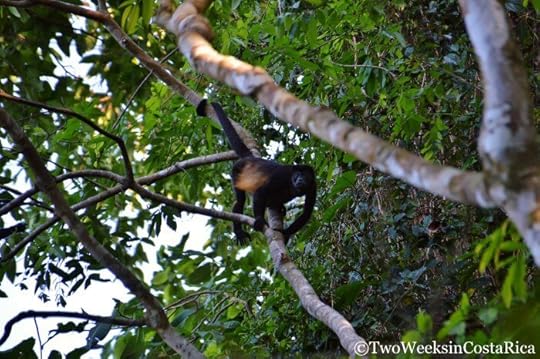
Howler Monkey along the trail
Crossing the Rio Claro
About two hours into the hike, you will have to cross the Rio Claro (Clear River). At low tide, this is as simple as wading through some swift moving, calf-deep water along the beach. At higher tides or after a recent rainstorm, however, the river will be much higher and you will have to cross by small boat. Luckily a local man named Ricardo offers to paddle people across for a small fee ($1-2). The money also helps Ricardo with his sea turtle conservation project and hatchery, which has been in operation for many years. Even if you don’t cross by boat, you’ll get the chance to walk through Ricardo’s place and maybe even purchase a handmade souvenir to benefit his good cause. He also offers kayak and waterfall tours.
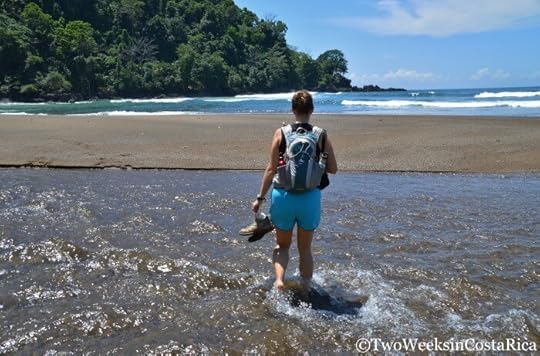
Crossing the Rio Claro at low tide
Playa San Josecito: Your Reward
About 20 minutes or so after the Rio Claro, you will finally reach Playa San Josecito. Like we mentioned above, this is the perfect place to take a refreshing swim after the long hike. The snorkeling is also really enjoyable if you have any extra energy left. Afterwards, you can relax under the shade of a palm tree, eat a picnic lunch, and rest your muscles for the long trek back to town. Sounds like the perfect day, and really it is!

The gorgeous Playa San Josecito
Tips for the Hike
What to Wear
Hiking Footwear: This isn’t a flip-flop-type hike so make sure to wear something comfortable that won’t cause blisters. When crossing the Rio Claro, you’ll probably want to take off your boots/shoes or wear something like Keens that can get wet.
Cool, Breathable Clothes: Lightweight breathable clothes are great because while you’re swimming at the beach, you can hang them up to dry on a branch and be much more comfortable on the return hike.
What to Pack
There are no facilities or changing areas at Playa San Josecito so you’ll need to carry in and carry out everything you need. Here’s a list to get you started:
Food and Plenty of Water: The beach has a few picnic tables but that’s about it. Ask your lodge to pack you a lunch or buy some things in town before you go.
Bathing Suit & Snorkel Equipment: Snorkel gear can be rented in town if you don’t have your own. Water shoes are also a good idea if you have them as the sand gets really hot.
Towels or a Lightweight Beach Blanket: Like we said, there are no facilities at this remote beach so if you want something to sit on, be sure to bring it along. Regular towels will do fine or a lightweight microfiber blanket that dries quickly like this one works great too.
Plastic Bags: To carry back your trash and wet bathing suit.
Insect Repellent & Sunscreen: Help protect the reef by using some natural options.
Head Lamp or Flashlight: The sun starts to set around 5:30 p.m. so if you’re still hiking back (remember it’s 2.5 hours), you’ll want one just in case.
First Aid Kit: For the occasional blister or scrape (both of us managed to get a blister on the long hike back on our most recent visit). Here’s what we carry.
Have you ever made the long hike to Playa San Josecito? Was it worth the effort?
Read more about Drake Bay, including our recommended hotels and restaurants, here: Drake Bay: Costa Rica Unplugged.
The post Playa San Josecito: Hiking and Snorkeling near Drake Bay appeared first on Two Weeks in Costa Rica.
July 29, 2015
Tortuguero National Park: A Wildlife Hot Spot
Two Weeks in Costa Rica |
Costa Rica has nearly 30 national parks, but if you’re a wildlife enthusiast, there’s one that stands out against all the rest. Tortuguero National Park, located in the northeastern-most part of the country, is brimming with exotic birds and animals. Along the zig-zagging canals, land trails, and beach, you’ll find everything from monkeys and turtles to caiman and wading birds. There are several ways to explore Tortuguero National Park. In this guide, we’ll share the different options and give some tips so that you see the most.

Park Setup
Tortuguero National Park is a vast protected area of land, water, and mangrove in the remote village of Tortuguero on Costa Rica’s Caribbean Coast. Because this area is extremely swampy, it is accessible only by boat or small plane. Plan on spending at least a couple of days in the village if you want to visit the park. For lots more information about visiting Tortuguero, read our post Tortuguero Off the Resort.
There are three main ways to explore Tortuguero National Park.
Canals
Probably the most popular way to see the park is on a boat tour through the canals. If you’re staying at one of the resorts, your hotel may include this kind of tour in your package. These hotels typically have their own boats, which are larger (holding around 10-15 passengers) and have a motor. For those opting to stay in the village at one of the smaller hotels, you can easily arrange a tour through the local association of guides, Asociacion de Guias de Tortuguero, for around $20 per person.
The benefit of going through the local guides is that they take you in a smaller, hand-paddled canoe. This allows them to go into the narrower offshoots off the four main canals that the motored boats are prohibited from accessing. They can also slip into tighter spots in the mangroves, helping you to see monkeys and other wildlife close up.
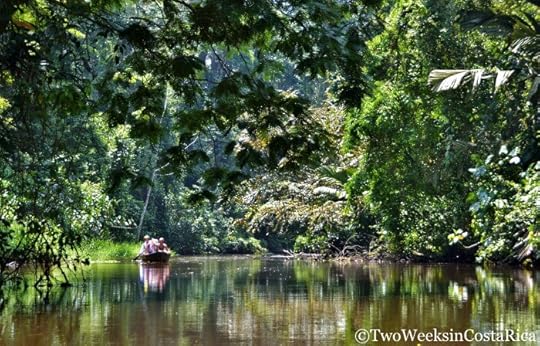
One of the smaller, hand-paddled boats cruising through the canals
Though less common, another way to explore the canals is by renting a kayak or canoe and going out on your own. This is what we decided to do since we’ve taken a lot of tours in Costa Rica and are getting fairly good at spotting wildlife. For most people, though, hiring a guide will add an incredible amount of value to the experience. The guides are locals who are extremely knowledgeable about the wildlife and know where to look so that you see many different species.
Land Trails
In addition to the canals, the park has a land trail near the ranger station right in town. If you can only do one tour, go for the canals, but if you have more time, the land trail is worth a visit as well. This path is normally a loop, but sometimes parts of it close due to mud. At the time of our visit, it was a nice long L-shaped trail that ran from one side of the peninsula straight across to the other then down a long stretch of beach. It took us about 3 hours to hike to the end and back.
Tip: A lot of people we talked to said that they didn’t see much wildlife along the trail, but luckily that wasn’t the case for us. Here are some tips to keep in mind when looking for wildlife. First, remember that animals are often hiding right in the trees above you. Unless they move, you’ll probably miss them because only rarely are they in plain sight near the trail. Second, keep your eyes glued to the canopy and walk slowly. If you see the trees move at all, keep looking because there’s probably a monkey or bird nearby.

Spider monkey quietly watching the tourists go by
The main part of the trail near the ranger station is known for getting extremely muddy. If it has been raining lately, which is often is in Tortuguero, rent a pair of rubber boots from one of the vendors outside the park ($1). The boots aren’t the most comfortable, but if you don’t wear them, you might find yourself covered in mud up to your knees. Be sure to bring some tall socks if you’re planning on a longer hike as the boots can get quite abrasive after a while.
Beaches
One of the most magical activities in Tortuguero National Park is the nesting turtle tour. Four kinds of sea turtles come to the park’s gray sand beaches to lay their eggs. Green turtles have the biggest population by far and are the easiest to see. Visit during July to October to witness a nesting event. If you’re lucky, you can also spot leatherback turtles between March and May. These gigantic creatures are extremely endangered so much more difficult to see, but if you can catch them, it’s a mystical experience. Turtle watching tours happen at night along the beach and can be arranged through the local association of guides for around $20 per person.
What You’ll See
Tortuguero has an amazing diversity of wildlife thanks to all the different kinds of habitat. On both the land trails and along the mangroves in the canals, you’re very likely to see several different types of monkeys. Howler monkeys, white-faced capuchin monkeys, and best of all, the more rare spider monkey can all be seen in the park. In the canals, you can also see some unique wildlife not found in many places in Costa Rica. Freshwater turtles, caiman and crocodiles, lizards like green basilisks and iguanas, and many species of birds can all be spotted by paddling along the brackish canals. Bird enthusiasts will want to have their cameras and binoculars handy for the array of interesting feathered friends. On our one-day visit alone, we saw an impressive 18 species, including an Anhinga, Great Curassow, Tiger Heron, Sungrebe, and this beautiful Green Heron.

Cost
$15 Foreigners, ₡1000 Nationals. Allows self-guided access to the canals and land trail; guided tours are additional.
Park Hours
6:00 a.m. – 4:00 p.m.
What to Wear/Bring
Long, lightweight pants and repellent to protect against the many biting insects.
If you’re taking one of the smaller boats or a kayak, you will want a dry bag to protect your phone or camera from getting wet.
A hat and sunscreen.
Plenty of water as Tortuguero is often hot and steamy.
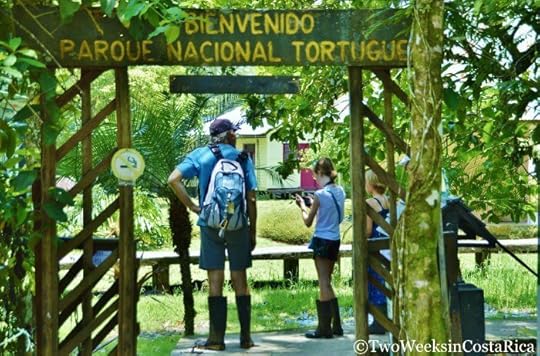
If you’re visiting Costa Rica to see wildlife, be sure to add Tortuguero National Park to your trip itinerary. Because Tortuguero is slightly hard to get to, it took us several years to finally make it there, but we’re so glad we did. Not only is the town itself quaint and charming, but the wildlife you’ll encounter is spectacular. It’s well worth a visit.
Want more information to help plan your trip? Check out these articles:
Tortuguero Off the Resort: Comprehensive guide to visiting Tortuguero, including recommended hotels, restaurants, and activities.
Getting to Tortuguero: Takes the mystery out of getting to this remote village. Info on arriving by plane and boat, driving directions, parking, and more.
Packing for Costa Rica – The Essentials: Step-by-step guide for exactly what to bring on your trip. Includes country-specific items that you may not think of.
The post Tortuguero National Park: A Wildlife Hot Spot appeared first on Two Weeks in Costa Rica.
July 22, 2015
Two Years in Costa Rica: How Life Has Changed
Two Weeks in Costa Rica |
When we first announced our decision to move to Costa Rica in July 2013, we joked that we were saying goodbye to our typical two week vacations, and hello to months, or even years in Costa Rica. How the time has flown. We almost can’t believe it ourselves, but tomorrow marks our two year anniversary of living here in the land of pura vida! With this milestone, we thought we would reflect back on how our lives have changed so far and give you a sneak peek into what the future holds for us.

Biggest Changes
Pace of Life
Our biggest change over the last two years has been the pace of life. We are constantly reminded by people contacting us through our website about what life used to be like for us. These stories always have the same theme: there is too much work, stress, and chaos in the day to day and something needs to change. Being reminded that we once felt the exact same way has been very enlightening, because after two years here, we realize much of that feeling has been wiped away. Life is a lot simpler now and we have more control over our work schedule (more on this later). That is not to say that moving to Costa Rica will solve all of life’s problems, far from it. We have been tested with power and water issues, the internet being out for days, major car repairs, and much more, sometimes all at once. In fact, as we write this, the mechanic has had our car for over five weeks, it’s an hour walk down a steep mountain to the bus stop, and the internet is out for the third day this week.
Attitude
Our attitudes have also adjusted over the last two years. The shift actually started before we moved. We try to take obstacles and frustrations in stride (like the car and internet) and enjoy things that are often passed by. Nature surrounds us every day and we make sure to take time to enjoy it. We’ve become avid birders and also really like to hike, walk, and go to the beach. When the power or internet goes down and we can’t work online, we try to make the best of it. We either sit outside watching the birds or go for a short hike until it comes back on. Maybe a sunny day during the week turns into a beach day and we work on a cloudy Saturday instead. Of course, when things are piling up and we still can’t get online, we do get stressed. There is no escaping work unless you don’t have to work at all.

It’s hard not to enjoy nature when it practically engulfs our house
Careers and Money
That leads us to another big change, our careers. We both had successful, steady jobs with good pay back in Boston. Do we miss them? No, not really. But switching to a life of writing and running a website, something much less stable, was a huge leap of faith for us. Adding to that stress is the fact that the cost of living in Costa Rica is fairly high, and things like groceries, rent, and gas are very similar to the States. Many people who move to Costa Rica have retirement money coming in, but since we are in our mid-thirties, we have to continue working. Since you cannot work in Costa Rica unless you are a permanent resident (something that takes years to obtain), we have had to rely solely on our writing and website for income. What’s great, though, is that we really enjoy what we do. We love hearing from people who have enjoyed our books and articles, or from clients returning from a great trip that we planned for them. There is something very rewarding about running your own business and seeing it grow over time.
Our daily lives are also a lot less stressful. As much as possible, we try to keep a normal schedule, working five days a week and stopping around five o’clock so that we have some time to relax. We also try to observe weekends as much as possible. Of course, we don’t earn anywhere near what we used to as a lawyer and construction manager, but we have figured out how to make enough money so as not to dip into our savings. This took us a while (almost the full two years), so if you are thinking of taking a similar path, make sure you have something to fall back on financially. Something that has really helped us has been eliminating the need to pay rent through house sitting and caretaking.
Language
As you can imagine, living in a foreign country, language has been a big change. When we first stepped off the plane two years ago, eight suitcases in hand, we couldn’t even speak enough Spanish to negotiate a fair price with a taxi driver at the airport. Needless to say, we paid way too much. But things have improved. After a lot of studying and hard work, now we can understand generally what someone is saying to us and are able to string together simple sentences.
But talking to someone and really talking to someone are two different things. We often find ourselves struggling the further into conversations we get. Day-to-day situations like at the bank, post office, electric company, etc. are fine, but when we’re talking with people we know well, it can be difficult to speak our minds. As an example, recently we couldn’t go to one of our friend’s kid’s birthday party because our car was broken. The next time we saw them, all we wanted to do was be able to tell them that we really wished we could have been there and that if our car hadn’t been in the shop, we wouldn’t have missed it for anything. Our limited Spanish can be very frustrating and makes it difficult to have deep, meaningful relationships where our true character shines through. But we continue to learn and practice and we know that with a little time, it’ll get better.
Feelings of Isolation
The language barrier definitely can be frustrating, but couple that with the fact that our closest friends and family are thousands of miles away, and feelings of isolation start to pile up. Of course, we have kept in touch with a lot of people, but as time passes the length between check-ins tends to get longer. We did make a trip back to the US last year, but the 18 days felt like it went by way too quickly. After that trip, we were left feeling that we did too much and didn’t get to spend enough quality time with each person we visited.
Making friends in Costa Rica also has been a challenge. We mentioned the language barrier but even making connections with other expats hasn’t been easy. This is mostly because we were traveling around the country for the first year and a half and didn’t stay long enough in one place to make lasting relationships. But it’s also because many people who have moved here are at a different stage in their life. Many are retiring, others are on some type of spiritual quest. There’s even people who are running from a major problem back home. We’re not the type to befriend everyone we meet and maybe that’s a good thing. Making more friends has been slow, but the ones we have are great. It will also be easier now that we are settled into one area for a longer period of time.
Our Future in Costa Rica
The biggest change is on the way!
All these changes over the last two years have definitely been a test for us. But we knew it wouldn’t be easy and we can honestly say that even with all the challenges, we still love living here. So what does the future hold?
Well, over the next year, we plan to continue to grow our website and business—and biggest of all—our family. Yes, that’s right. Jenn is five-and-a-half months pregnant and we’re expecting a baby boy this November! This will be our biggest adventure yet and we are beyond excited. We’re not sure exactly how long we will stay in Costa Rica, but one of the reasons we moved here was to start a family and have the ability to be present during those first years so we aren’t planning to go anywhere anytime soon. We can’t imagine a more fun place to grow up than in Costa Rica and are excited to watch our baby take in this beautiful country.

Jenn with the baby bump
So there’s an honest roundup of our first two years living in Costa Rica. We’ve laughed, we’ve cried, and we’re having a baby. Stay tuned for more updates as we continue our adventure and a big thank you to all our readers for following along!
Want to follow our story from the beginning? Check out these posts:
We’re Moving to Costa Rica!
First Impressions on Living in Costa Rica
Living in Costa Rica: One Month Update
Buying a Car in Costa Rica
Fun Facts From Our First Six Months in Costa Rica
Our First Year in Costa Rica
House Sitting: How to Live in Costa Rica for $2,000 a Year
The post Two Years in Costa Rica: How Life Has Changed appeared first on Two Weeks in Costa Rica.
July 15, 2015
Driving in Costa Rica: What to Know Before You Go
Two Weeks in Costa Rica |
Driving in Costa Rica can be intimidating for a first- or even second- or third-time visitor. When we traveled to Costa Rica as tourists, we most often took the bus or shuttles. It took us several trips to gain the courage to finally get behind the wheel. But once we did, we never went back. Having a car in Costa Rica gives you the freedom to stop and go as you please, opening up a world of possibilities. And with a little knowledge and experience, you’ll lose the nerves and be ready to take on the open road for yourself.
We’ve driven all across the country over the last two years from the Caribbean Coast to northwestern most Guanacaste, the central mountains to the southern Pacific, and everywhere in between. Here are our tops tips for driving in Costa Rica.

General Information
In Costa Rica, all you need is a valid driver’s license from your home country to operate a vehicle. Also be sure to have your passport or a copy handy in case you get pulled over. There is no requirement for an international driver’s license. In general, the rules of the road are probably similar to what you’re used to back home. Lanes are marked with double solid lines when passing is not allowed and hatched lines when passing is permitted. Speed limits (in kilometers) are posted with signs, though usually not as frequently as what we were used to in the US. Seatbelts are required and children under the age of 12 are supposed to be restrained in car seats or booster seats.
Although these are technically the requirements, enforcement is another issue. The rules are bent everywhere you go. As an example, it’s very common in rural areas to see entire families on motorcycles with kids as young as two riding sandwiched between mom and dad.
Road Conditions
Roads vary from well paved two-lane highways to pothole-ridden dirt roads with treacherous river crossings. Most of the roads in and around the capital of San Jose are nice and smooth, but once you get out of the city, conditions can change a lot. Costa Rica’s topography is extremely diverse, with everything from lofty mountains and low visibility cloud forest to flat plains and farm fields. While many areas are accessible without four-wheel drive, many are not. Be sure to research in advance if 4X4 and higher clearance are necessary to access the specific places you’ll be visiting.
For more information about renting a car in Costa Rica and how you can save 10-25%, be sure to check out our Rental Car Discount page.
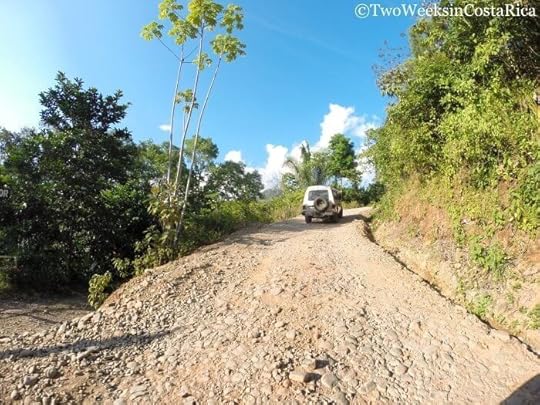
Typical rough road in a rural area of Costa Rica
Signage
You’ll find during your visit that signs throughout the country are generally lacking. Most roads are not marked with street signs at all. In San Jose, sometimes major streets are marked with signs or on the walls of buildings, but more often, not at all. In rural areas and beach towns, signs are also somewhat of a novelty. While you might see signs letting you know how far away a certain town is, it is very rare that a road or highway will be marked with the route number. Exits along highways are also notorious for being poorly marked or having very small signs right at the turnoff. For these reasons, we recommend that people using our Rental Car Discount add a GPS to their rental or use some type of map program on their phone. The Waze App is a very popular and accurate one.
Rainy Season – Washouts and Landslides
If you’re traveling in the rainy season (May to November), something to watch out for is washouts and landslides. Some roads are more prone to these events than others and it’s always good to ask your hotel about current conditions before setting out. Roads to be extra cautions on are Route 2 between San Jose and San Isidro del General; Route 32 between San Jose and Limon; and Route 27 connecting San Jose to Puntarenas and Jaco.

A big landslide on Route 2 between San Jose and San Isidro del General
Pedestrians and Bicyclists
A lot of locals don’t have cars and get around mostly by foot or on bike. You’ll see men coming from work donning machetes and families with children in tow in the breakdown lane of busy roads. Always be on the lookout for people in the road, especially at night, as they aren’t usually wearing reflectors.
Another thing to keep in mind is that pedestrians do not have the right of way. So in urban areas, people trying to cross the road won’t expect you to stop for them. If you do stop, just be careful not to get rear-ended.
Motorcycles and Dirt Bikes
Motorcycles and dirt bikes are other popular ways to get around. Some motorcycles don’t reach the same speeds as cars. On highways, these guys will often pull way over to the right when a car comes behind to let them pass. If this happens to you, just go ahead and pass when it’s safe.
In San Jose, where there’s a lot of traffic, also be aware of motorcycles and scooters weaving in and out of lanes and in the breakdown lane. Sometimes they get so close to your car that they almost run into you.

Motorcycles weaving in between traffic in downtown San Jose
Potholes
Costa Ricans have some unique ways to convey that something is awry in the road. For example, potholes are often marked with whatever is lying around. A palm frond or a big stick with a potato chip bag as a reflector sticking out of a hole does the job of letting you know that there’s a pothole ahead.
Creative Use of Hazards
Locals often put on their hazard lights to let the car behind them know of a problem up ahead. This can be especially useful if you’re coming fast around a corner and traffic is stopped because of an accident or construction. To signal oncoming traffic of a problem, the standard flashing of the headlights is also common practice.
Tractor Trailers
Costa Rica is in a major shipping route from Panama to North America and also has major ports on each coast so tractor trailers frequent many of its roads. Something to be aware of when following a tractor trailer is that they will often use their left turn signal to let you know when it’s safe to pass. What they consider safe and what you do might be different though so be sure to pass with caution.
Passing
One of the biggest things to be aware of when driving in Costa Rica is unsafe passing. We have seen too many overturned tractor trailers and had many close calls ourselves not to emphasize this point. The fact is, a lot of people pass without much regard to oncoming traffic. While it seems callous, it’s the way of the road here. You will see people passing uphill, on curves, and in other places where it is not possible to see if an oncoming car is approaching. There isn’t a lot you can do to control other people’s driving, but remain alert and cautious. We always try to leave enough space between us and the car in front of us so that we can avoid an accident and also go the speed limit so that we have time to react.
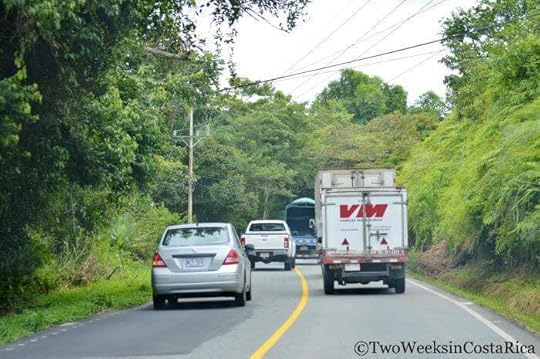
Passing up a hill – not a great idea
Driving at Night
Until you’re comfortable driving in Costa Rica, avoid driving at night. Street lighting is used a lot less frequently than what you’re probably used to. Couple that with narrow and curvy roads with no guardrails, and it can be downright scary to drive after dark. When we bought our car in Costa Rica, we had to drive it back along a curvy mountain road that recently had been paved. It was pouring rain and they hadn’t painted the lines so all we had to keep us out of the ditch were a few reflectors visible in between bolts of lightning. Not painting the lines may sound like a temporary problem but sometimes it takes road crews months to get around to it.
One-Lane Bridges
To save on costs, a lot of bridges in Costa Rica are only one lane wide. This means that you have to take turns with oncoming traffic to pass. The general rule is whoever gets there first has the right of way. These bridges sometimes come up fast so be on the lookout for “Puente Adelante” (Bridge Ahead) signs.
River Crossings
Some rural areas of the country have roads that require river crossings. Depending on the time of year, it can be a small stream passable with a regular sedan or a gushing river not recommended with even a large truck or SUV. The first thing to keep in mind is that river crossings void most rental car agreements so your insurance won’t cover any damage. If you do decide to cross a river, always be sure to wade through first on foot to check the depth. It’s also a good idea to watch another car do it first to see the path they take. If the river is tidal, check the tide charts before setting out to time your crossing right. Often, there’s an alternate route that avoids river crossings altogether, so if it looks at all dubious, ask a local if there’s safe passage another way.

Crossing a river near Nosara
Checkpoints
Along major routes, you may see police checkpoints set up, often near international borders. They may stop every car or one every certain number. Usually, they only want to know where you’re going and sometimes will want to see your passport. Don’t be alarmed; these checkpoints are routine. Just cooperate and you’ll be on your way in no time.
Accidents
If you get in an accident, call 911 and your rental car company. Also be sure not to move your car. The police and an insurance agent will come to assess the accident and damage, and the rental car company will come to help and give you a replacement car.
Gas Stations
Gas stations are located throughout the country but are sometimes spaced out. Be sure to fill up in advance when driving a long distance if you’re not sure where the next station is. Keep in mind that all the gas stations in Costa Rica have the same government-regulated prices so there’s no need to shop around. Gas stations are full-serve and the people working are almost always helpful. If you need your oil or washer fluid topped off or some air for your tires, just ask.
Protecting Your Valuables
Rental cars are targets in Costa Rica because many of the models are the same. It’s easy though to keep your valuables safe by following a few simple steps. The first is to never leave anything in sight inside the car—even things with seemingly no value. This goes for at the beach, the grocery store parking lot, or anywhere else. Thieves are sometimes watching from afar and will strike even in the time it takes to go from your car to bring back the shopping cart. Always lock your doors and bring your valuables with you; otherwise, leave someone in the car to keep watch.

Can you spot the non-rental car?
Note that a lot of restaurants, national parks, and other tourist attractions have attendants to watch your car. Sometimes they are paid by the business, but usually they are just self-appointed watchmen and this is their primary job. They watch your car in exchange for a small tip (a dollar or two depending on how long you’re there). We’ve always had great luck with these guys, both in terms of security and in getting the inside scoop. As an example, the parking attendant at Carara National Park once told us about some tent-making bats hiding under a leaf that we had walked right by.
* * *
Driving in Costa Rica is definitely an adventure but as long as you’re cautious and remember these tips, you shouldn’t have any problems.
Have you ever driven in Costa Rica? What did you think?
Want more info to get ready for your trip? Check out these articles:
Packing for Costa Rica: The Essentials – Step-by-step guide for just what to bring, no matter where you’re visiting or the season.
Cost of Traveling in Costa Rica – What to expect for hotels, restaurants, tours, and transportation, plus tips to help save you money.
Costa Rica: Your 2-Week Itinerary – Detailed itinerary for what to see and do in two weeks in Costa Rica.
Costa Rica Rental Car Discount – Save 10-25% on a rental car by using the form on our website.
The post Driving in Costa Rica: What to Know Before You Go appeared first on Two Weeks in Costa Rica.
July 8, 2015
Birding in Carara National Park
Two Weeks in Costa Rica |
Only a short drive from one of Costa Rica’s most popular and developed beach towns is an oasis of nature. Carara National Park, just north of Jaco, not only has impressive jungle and easy trails, but this park is considered one of the country’s best birding destinations. Even if you aren’t a serious birder, it’s hard not to appreciate that over 400 species have been identified here. In this post, we’ll give you an overview of the park, tell you why it attracts so many different birds, and share which ones we saw during a recent visit.

The Violaceous (Gartered) Trogon
Orientation
Carara National Park or Parque Nacional Carara is located on Costa Rica’s central Pacific coast just 22 km (14 miles) north of Jaco and about 70 km (44 miles) from the international airport in San Jose. From the coast, the 5,242 hectare (12,953 acre) park stretches east into the mountains. The best public access is at a ranger station right off the Costanera Highway (Route 34), near the town of Tarcoles.
The location of Carara National Park is key to attracting birds and other wildlife. This park sits in what biologists call a transition zone. To the northwest of Carara, higher temperatures and lower rainfall create what is called the tropical dry forest. To the south, higher rainfall creates much lusher, tropical rainforest. The coast provides its own unique habitat. And inland mountains create wet forest with some primary (old growth) forests that have been around for centuries. Carara National Park sits between all of these so called life zones and has some elements of each. This makes it the perfect meeting place for birds that normally aren’t seen near one another and great for birders looking to spot them.
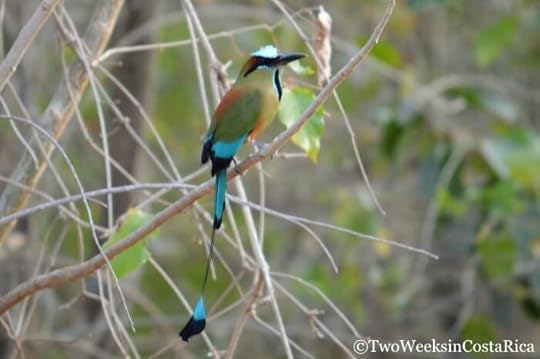
The Turquoise-browed Motmot is normally found in Costa Rica’s northwest. Carara is the southern range limit.
Trails
Exploring Carara National Park is easy. A single trail can be done for just an hour or you can hike them all in about a half day. Here’s a picture we took of the trail map to help you plan.
From the ranger station, one main trail, the Universal Loop (1.2 km/0.75 miles), circles through shaded forest with shrubby undergrowth. This short trail is flat, paved with concrete, and has resting benches, a bathroom facility, and many informational signs that give details on the flora and fauna. This is the most popular trail for casual tourists but still has a lot of birds.
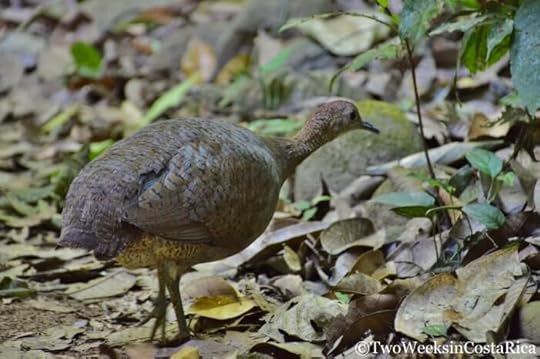
A Great Tinamou seen along the Universal Loop Trail
About halfway through the Universal Loop, the Quebrada Bonita Trail (1.5 km/1 mile) branches off. This trail is much more rustic and what you would typically think of as a hiking trail. It is also fairly flat but not paved and has some roots and steps to traverse. This area has taller trees, some of which are upwards of 100 years old, and a nice bridge over a river. A third trail, the Araceas, branches off the Quebrada Bonita and makes another 1.2 km (0.75 mile) loop. This trail is even more rustic and has lots of steps. Essentially the farther you go along these three loops, the less foot traffic you will encounter and the harder the hiking is.
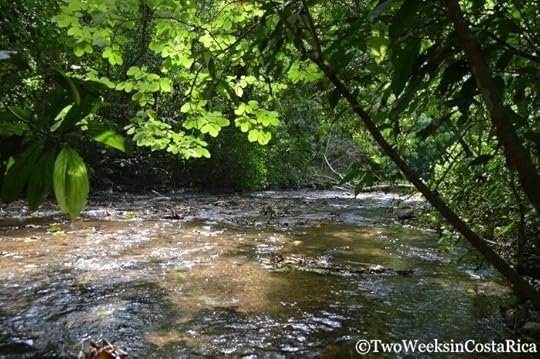
The Quebrada Bonita (translates to Beautiful Stream)
A separate trail, the Meandrica or Riverside Trail, is located about 2 km (1.2 miles) north of the main ranger station. This is the place to go if you’re serious about birding. To access this trail, you have to drive a couple of minutes north on the highway and park at a separate lot after checking in at the main ranger station (look for a gate on the right). A parking attendant will watch your car in exchange for a small tip.
The Meandrica Trail (4 km/2.5 miles) is flat but had many obstacles like downed trees to climb over when we visited. The nice thing about the Meandrica Trail is that the vegetation is lower and there are several clearings, which are perfect for birdwatching. It also leads to some ponds next to the river, which are great for viewing a variety of wading birds like herons. For these reasons, we recommend birding the Meandrica Trail first (early morning is best) and visiting the other trails, which are deeper into the woods, afterwards.
Birding in Carara National Park: Our Species List
We are far from expert birders but our enthusiasm outweighs our lack of skill. Having read up about all the different birds on the Meandrica Trail, we birded that first. We walked this trail for about 3 hours, stopping almost constantly with each shake of a bush or strange call. Some of the highlights for us were the Orange-collared Manakin, both the Gartered and Black-throated Trogon, a Pale-billed Woodpecker, Bare-throated Tiger Heron, and best of all, a pair of Scarlet Macaw Parrots that were in the middle of mating.
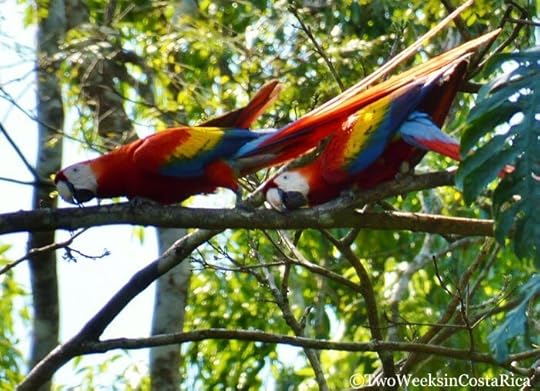
A mating pair of Scarlet Macaw Parrots
In total, we were able to identify 17 different species along the Meandrica Trail. In addition to the ones mentioned above we saw: the Tawny-winged Woodcreeper, Ruddy-tailed Flycatcher, White-tipped Dove, Black-hooded Antshrike, Clay-colored Robin, Turquoise-browed Motmot, Squirrel Cuckoo, Yellow Warbler, Northern Waterthrush, Prothonotary Warbler, Streaked Flycatcher, and many more that we weren’t sure about.
Afterwards, we drove back to the main ranger station and set off on the three loops, starting at the Universal. It was mid-day at this point and many of the birds were hard to identify, hiding high in the canopy or deep in thick brush. Still we were happy to add four more interesting species to our list. We spotted the Slaty-tailed Trogon, Golden-crowned Spadebill, several Great Tinamou, and a half-dozen Marbled Wood-quails.

A Slaty-tailed Trogon overhead on the Quebrada Bonita Trail
Tip: It’s almost always best to get an early start when birding but this is especially true in Costa Rica where temperatures heat up quickly and the hot sun can keep birds hiding or resting in the thick brush.
Other Highlights
Although birding was slow for the second part of our hike, a highlight was the many animals we saw. On the Quebrada Bonita Trail, we happened upon a big troop of white-faced capuchin monkeys, and later on the Araceas Trail, a small family of howler monkeys with babies. On the way back, we even saw some agouti, a small rabbit-type animal, crossing the Universal Trail.

A White-faced Monkey on the Quebrada Bonita Trail
The park is also a nice place to spend the day just for its beauty. Huge trees climb into the sky, broad-leafed plants and flowers border the trails, and gorgeous streams and ponds glisten in the filtered sunlight. If you’re visiting the area and want to see wild forest, we definitely recommend it.
Park Information
Hours
Open daily. Low Season Hours (May to November), 8:00 a.m. to 4:00 p.m. High Season Hours (December to April) 7:00 a.m. to 4:00 p.m. Note: The ranger station closes from 12:00– 12:45 p.m. for lunch.
Admission
$10 Foreigners, ₡1000 Nationals
Guides
The local association of registered tour guides has several guides onsite daily. Small group tours are $25 per person and larger groups are negotiable.
Directions
Carara National Park is located right off the Costanera Highway (Route 34). The park entrance is 22 km (14 miles) north of Jaco or 2.5 km south of the Tarcoles River Bridge. Look for the small sign and parking lot on the eastern side of the highway.
Looking for more information to plan your trip? Check out these posts:
Jaco, Costa Rica’s Booming Beach Town: Just south of Carara National Park, this tourist mecca has plenty of activities, restaurants, and shops to keep everyone else entertained while you go birding.
A Riverboat Adventure with Jose’s Crocodile River Tour: More than just crocodiles, the Tarcoles River runs right near Carara National Park and has dozens of bird species along its banks. We spotted our first Roseate Spoonbill on this tour!
Packing for Costa Rica – The Essentials: Packing list that will have you ready for anything. Special tips for rainy season travel and Costa Rica’s many micro-climates.
Costa Rica Rental Car Discount: Save 10-25% with this special discount for our readers.
Also, for a complete birding itinerary that will take you all across Costa Rica, check out the Birding chapter in our new book, Top 10 Costa Rica Itineraries.
The post Birding in Carara National Park appeared first on Two Weeks in Costa Rica.
July 1, 2015
Rincon de la Vieja National Park: Volcanic Vents and Tropical Forest
Two Weeks in Costa Rica |
Costa Rica’s Guanacaste Province in the northwestern part of the country is a popular spot for surfers and beachgoers alike. But many visitors to this relatively flat and dry coastline are also looking to explore some rainforest and volcanoes. Luckily, just a short drive away, there are both. Rincon de la Vieja National Park has all the makings of a great day trip from the beach. In this post, we’ll give you everything you need to plan your visit.

Orientation
Rincon de la Vieja National Park is a special place because it sits in a part of Guanacaste where the flat plains meet the jungle-filled mountains. For this reason, in dry times of year like the busy tourist season (late December to April), the area will remain green and vibrant. Since there is more vegetation, there are also better chances to spot wildlife. Another big draw of Rincon de la Vieja National Park are the many volcanic elements. Active steam vents and bubbling mud pots can be seen right along the trails.

The transition from dry plains to green rainforest
Rincon de la Vieja National Park is located about 25 km (15 miles) northeast of Liberia, the capital city of Guanacaste. It’s about 2 hours inland from popular beach towns like Tamarindo and Playa Flamingo and even closer to Playa Hermosa (1.5 hours). The 14,300 hectare (35,336 acre) park has two public entrances, one at the Santa Maria ranger station and another at Las Pailas station. We visited Las Pailas ranger station, which is a bit easier to access. For detailed directions, see the end of this post.
Overview of Trails
Las Pailas ranger station has two main trails. Las Pailas Trail is a 3 km (2 mile) loop that passes through thick rainforest and some open fields. This is the most used trail because you can see volcanic features (more on this below). The first part of the trail is also very scenic, with a short hanging bridge that crosses a river, a small waterfall, and really thick forest. Las Pailas Trail is moderately difficult because of uneven ground and many large roots and rocks. Expect to spend at least 2-3 hours on Las Pailas Trail and be sure to read our tips on what to bring below.
Here’s a photo we took of the trail map that you might find helpful.

A section of the Las Pailas trail with lots of roots and rocks
The second trail is the Sendero de las Cataratas or Trail of the Waterfalls. This trail actually splits into two trails about halfway through, each leading to a different waterfall. These trails are longer and more difficult. Combined, they add up to about 18 km (11 miles) and would take most of the day for an experienced hiker. Keep in mind that the waterfalls are seasonal, so not worth the trek during the dry season when little or no water is flowing. Be sure to ask the ranger about current conditions before you start the hike.
For those hoping to climb to the summit of Rincon de la Vieja, there is a third trail, the Sendero Crater Activo or Active Crater Trail. Unfortunately, this trail is closed and will probably remain so for the foreseeable future. This is due to high volcanic activity and dangerous gases coming out of the volcano’s crater and vents. Better to stick to the trails around the base of the volcano like Las Pailas.
What You’ll See
The first part of Las Pailas Trail is mostly thick jungle, which makes it good for seeing wildlife. We were able to spot some coati (a raccoon-like animal with a long nose and thin tail), lots of lizards, butterflies, and some other interesting insects. We also saw different bird species, including Long-tailed Manakins. These are black, blue, and red birds with two long and wispy tail feathers. They are somewhat rare and it was our first time seeing them so we were really excited.

The Long-tailed Manakin
After passing a small waterfall (only a trickle during our visit), Las Pailas trail leads to one of the most impressive features of the park: steam vents, also called fumaroles. These basically look like big holes in the ground that constantly billow steam, while making strange gurgling sounds and giving off a stinky sulfur smell. The fumeroles can reach temperatures in excess of 200˚F (93˚C) so it is really exciting to be able to see them close up.
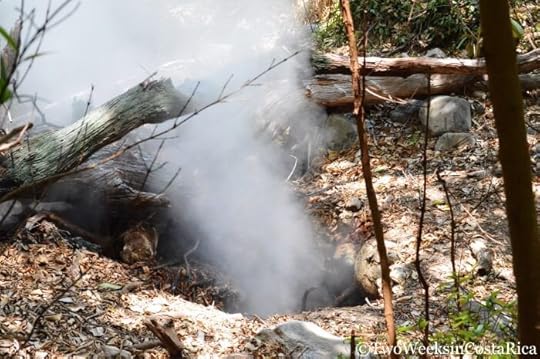
One of the steam vents or fumaroles
Farther on the trail, the forest thins out and there are more volcanic features to discover. Although during our visit it was too dry for the mini mud volcano to be active, we have heard that with a little rain it can be quite impressive, spitting up mud almost constantly. The bubbling mud pots nearby were active though and were very intriguing. Tiny bubbles from underground heat and gases constantly churned the thick, gray mud to make it silky smooth. This volcanic mud is the same kind that is used for body and facial masks, so if you want a closer look, hit up one of the spas in the area after your time at the park.

Silky smooth mud bubbling from the ground
The last section of Las Pailas Trail goes through an open field before looping back into the forest. This section is almost desert-like during the dry season but also really beautiful. Smaller trails off the main one lead to several acidic ponds, also bubbling from the underground volcanic heat and gases. Like other features along the trail, these ponds are sectioned off so you can’t get too close. But even from a distance, they are really impressive and have an array of colors caused by the chemical reactions taking place.
What to Wear/Bring
A trip to Rincon can be uncomfortable if you aren’t well prepared. We saw a few hikers who either weren’t wearing the proper gear or didn’t bring enough water. And they didn’t hesitate to express their discomfort to us- Don’t let this happen to you! Here are the essentials to make sure you have a great visit:
Closed-toed shoes, sneakers, or hiking boots – Although parts of the trail are flat and easy, if you do the complete loop, you will have to traverse some slippery and steep spots.
Sun Protection – A hat and sunscreen are the biggest things you will need, especially for the last part of the trail when you are in direct sunlight.
Water and Snacks – The ranger station is remote and there aren’t any stores nearby. Be sure to stock up on things when passing through Liberia. Water is especially important because of the heat, often creeping up over 90˚F (32˚C).
Insect Repellant – Some parts of the trail are bug free but we did encounter a few swarms of mosquitos near the small waterfall.
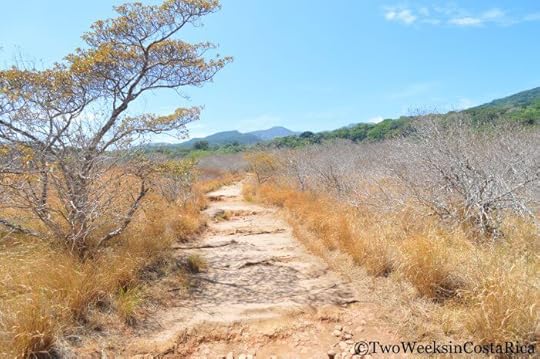
The last section of the trail can be really hot. Make sure to pack extra water.
Park Hours
Las Pailas Sector: 7:00 a.m. – 3:00 p.m. Tues. – Sun. (Closed Mondays)
Santa Maria Sector: 8:00 a.m. – 4:00 p.m. Every Day
Price
$15 Foreigners, ₡1000 Nationals
Directions
From Liberia, take the Pan American Highway (Route 1) going north. Drive 5.8 km (3 miles) and turn right at the sign for Curubande and Rincon de la Vieja National Park – Las Pailas sector. Stay on this road through the village of Curubande de Liberia. Watch for signs to Rincon de la Vieja National Park – Las Pailas sector. Eventually you will come to a gate and the road will turn to dirt. At the gate, you must pay an attendant (700 colones, about $1.50, when we visited) for access to the private dirt road. Continue on the dirt road for 20 minutes and you will come to Las Pailas parking lot and park entrance.
Tip: Although the road is dirt and somewhat bumpy, it is in good condition and regular non-4×4 cars were having no problem accessing the park entrance.
Have a question about Rincon de la Vieja National Park? Ask it in the comments below.
Visiting Northern Guanacaste? Here are more articles on places to see and things to do in the area:
Llanos de Cortes – A gorgeous waterfall right off the highway just outside Liberia.
The Big Cats of Las Pumas Rescue Center – A wildlife rescue and rehabilitation center with pumas, jaguars, ocelots, toucans, parrots, and many more animals.
Tamarindo: Where Paradise Meets Convenience – Destination Guide to the popular surf/beach town of Tamarindo, including recommended hotels and restaurants.
Playa Conchal: The Allure of Shell Beach – Tips for visiting one of Costa Rica’s most gorgeous beaches and info on the all-inclusive Westin Resort.
The post Rincon de la Vieja National Park: Volcanic Vents and Tropical Forest appeared first on Two Weeks in Costa Rica.
March 25, 2015
Rafting the Sarapiqui River with Outward Bound Costa Rica
We recently had the opportunity to go whitewater rafting down the Sarapiqui River in Costa Rica’s northern lowlands. Most people who make this trip go with one of the country’s many tour operators, but our experience was quite different. That’s because instead of a typical tour company, we were in the trusted hands of Outward Bound Costa Rica. We didn’t know much about this adventure-based leadership program before we started, but after splashing through rapids for the day, we learned a quite a bit.
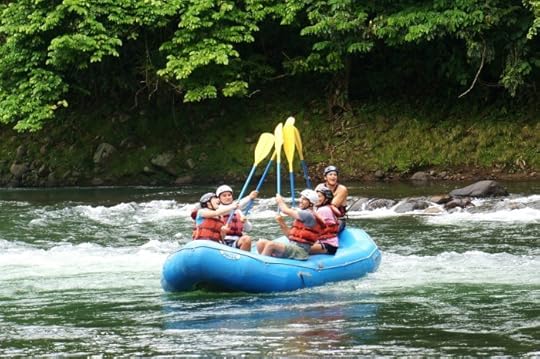
Photo credit: Outward Bound Costa Rica
On a beautiful sunny morning in downtown San Jose, we met up with Outward Bound staff, including founder and director of the Costa Rica program, Jim Rowe, and marketing coordinator, Lauren Salisbury. Jim and Lauren introduced us to a few other bloggers and journalists who would be joining us for Outward Bound’s first ever Media Day. After some brief introductions, they told us a little about the organization. We learned that the overarching goals are to teach students about themselves, foster leadership, and build character through challenging experiences. Rafting, sailing, scuba diving, surfing, endurance hiking, and solo excursions—anything that takes participants out of their comfort zone—are incorporated into the programs. Soon we’d experience a sample of this for ourselves.
After a bumpy ride through the steamy rainforest, we arrived in the small town of La Virgen. With the mighty Sarapiqui River flowing right next to us, we strapped on our helmets, fastened our life jackets, and gathered for the all-important safety talk. This was Jenn’s first time whitewater rafting. Not knowing what to expect, she was a bit nervous to say the least. Luckily one of the Outward Bound gap-year students named Zoe put her at ease. Leading the group in her very first safety demonstration, Zoe told us the different commands to listen for like “go high side” if the boat was about to flip and how to stay safe if you do fall out.
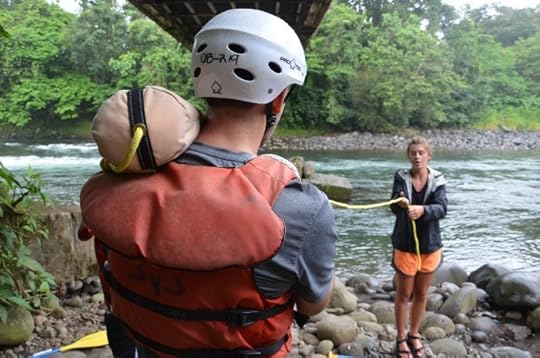
Photo credit: Outward Bound Costa Rica
We had gotten to chat with Zoe, who is in her early twenties, during the van ride. She was toward the end of her approximately 80-day program and had realized a lot about herself in that time. She had even decided on what graduate program to attend once she returned home to New Zealand.
Pushing off from the bank, we did a few practice drills in the calmer water and then it was time for the fun to begin. Jim, the program director, was our guide and steered us through the churning class 2 and 3 rapids with ease. We repeatedly bounced and splashed through the many runs, maneuvering over rocks and getting drenched in the process. It didn’t take long for Jenn to become comfortable on the water. In just a few runs, she stopped worrying about falling off, became more confident, and really began to enjoy the experience.

Jenn enjoying her first rafting adventure.
Farther down the river, Jim offered up the chance for others to take over as guide. He said that they often do this with their students. Putting them in charge of the raft, he said, helped to hone their leadership skills and show them that they can do more than they think. He also said that captaining is a good metaphor for life in many respects. One example was the parent-child relationship. By putting the student in command of the boat, they realize what it is like to be responsible for others. More importantly, they also realize that it is nearly impossible not to make mistakes when figuring out the best course of action. Putting the students in this position helps them understand, and perhaps be more forgiving of, their parents’ decisions.
The program may emphasize leadership and personal growth, but as we found out, its method of teaching is pure fun. We saw it on the river and heard it from Zoe as well. Zoe had told us that she had already spent several days sailing, surfing, and that the next stop for her group was the Caribbean islands of Bocas del Toro, Panama. There, they would be enjoying some scuba diving, island-hopping by kayak, and a visit to an indigenous community. For some added fun during our visit, we took part in a group jump into the river. Nine of us gathered at the top of the riverbank, holding hands, and on the count of three jumped into the swift-moving river.

Photo credit: Outward Bound Costa Rica
For us, Costa Rica has been a life-changing place and it was wonderful to be around a group of people who see it the same way. If you or your kids are looking for a cool way to experience the country, we highly recommend checking out Outward Bound. They have adventures for high-school kids on summer break and college-age students looking for a unique way to spend a semester or gap year. And from our brief time with them, we know they will be in good hands. You can check out all of Outward Bound’s programs at http://outwardboundcostarica.org/programs/.
Thanks to Outward Bound Costa Rica for a fun and informative day of rafting. As always, all opinions are our own.
The post Rafting the Sarapiqui River with Outward Bound Costa Rica appeared first on Two Weeks in Costa Rica.

